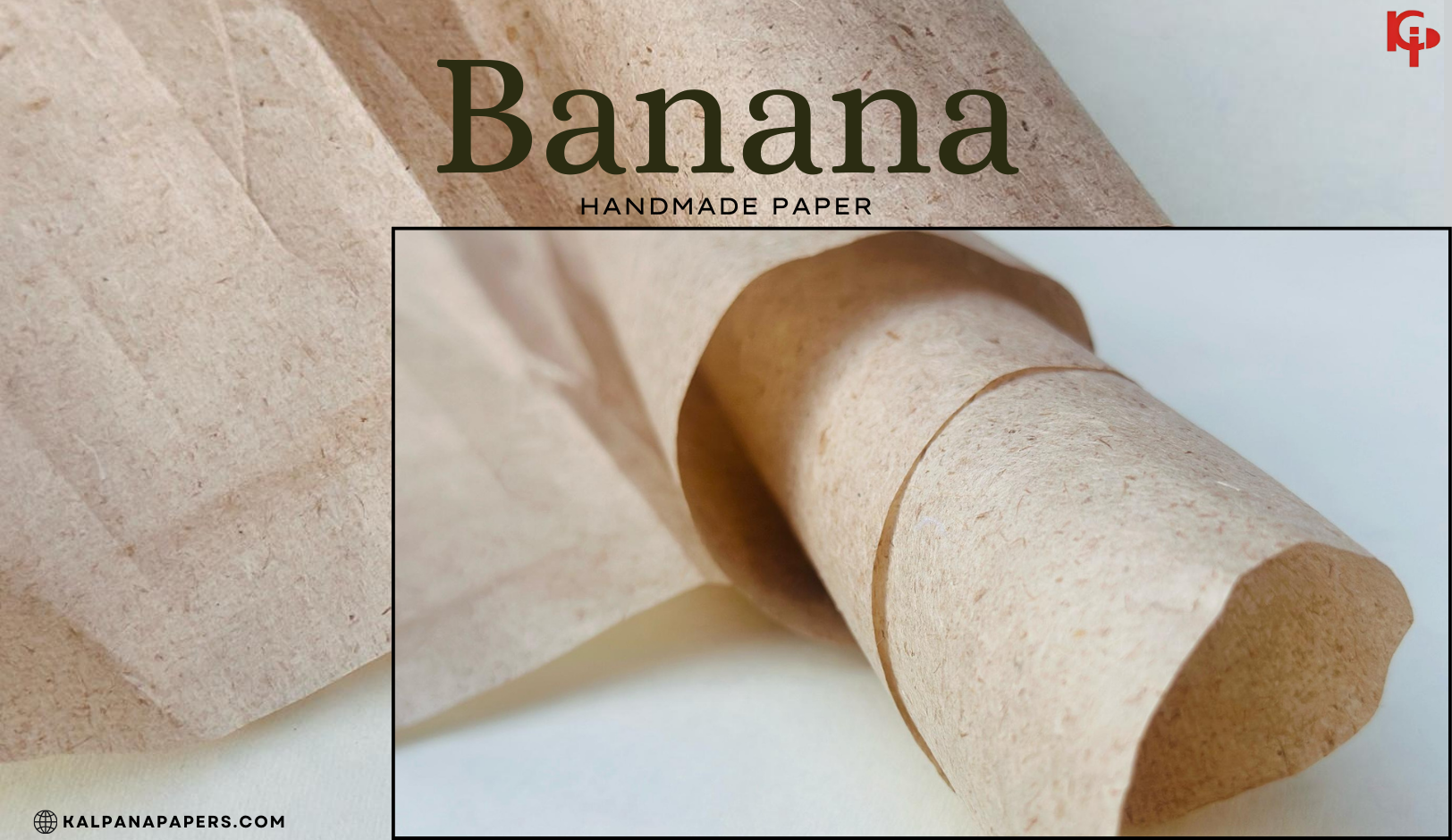28-Aug-2025 by
Handmade PapersHow Is Banana Fibre Turned Into Handmade Paper?
Introduction: The Beauty of Banana Fibre
Banana paper is one of the most unique forms of handmade paper in the world of eco-friendly creations. It is crafted using banana fibre, a natural material obtained from the banana plant. For centuries, people have used handmade paper for art, writing, and design, but banana handmade paper is now taking the spotlight because it transforms something often considered waste into something beautiful and useful.
This blog will walk you through the complete process of how to make banana paper, its benefits, uses, and why it’s the perfect sustainable choice
What Is Banana Paper?
If you’ve ever wondered “What is banana paper?”, the answer is simple: it’s handmade paper made from banana fibre extracted from the stem of the banana plant. Unlike regular paper made from tree pulp, banana handmade paper uses fibres that would otherwise be thrown away.
Banana paper has a unique texture, durability, and natural beauty. It’s often used for A4 paper sheets, banana design stationery, art projects, and even functional products like banana paper plates
Why Banana Fibre?
Banana fibre is strong, flexible, and naturally eco-friendly. When we think about how to use waste banana tree parts, banana fibre becomes an ideal choice. Normally, the stem of a banana plant is discarded after the fruit harvest, but in banana handmade paper making, it is turned into a valuable resource. This process reduces waste, saves trees, and promotes sustainability.
Step-by-Step Process: How to Make Banana Paper
Here’s how to make banana into paper using a fully organic and eco-friendly process:
1. Collecting Banana Fibre
The process begins with collecting banana fibre from the banana plant stem. These stems are rich in long, strong fibres perfect for handmade paper making.
2. Cleaning and Preparing the Fibre
The banana fibre is washed thoroughly with clean water to remove any dirt and impurities. This step ensures the paper will have a smooth and natural finish without using any chemicals.
3. Soaking the Fibre
To soften the fibre naturally, it is soaked in water for several hours or days. This makes it easier to break down during the papermaking process.
4. Breaking Down the Fibre
Once soft, the fibre is manually beaten or blended into a pulp using traditional tools. This pulp is the base of banana paper.
5. Forming the Sheets
The pulp is spread evenly on a screen or mould, shaped into sheets such as A4 paper or larger sizes. This is where banana design creativity comes in—you can add textures, patterns, or pressed flowers for unique banana handmade paper designs.
6. Drying Naturally
The sheets are then sun-dried naturally. This eco-friendly drying method keeps the process 100% chemical-free and energy-saving.
Creative Uses of Banana Handmade Paper
Banana paper is versatile and can be used in many ways:
-
Stationery & Writing: A4 paper for letters, notes, and office use.
-
Art & Craft: Perfect for painting, sketching, and banana design artworks.
-
Invitations & Greeting Cards: Adds an organic touch to special occasions.
-
Eco-Friendly Products: Learn how to make banana paper plate for events—ideal for replacing single-use plastic plates.
-
Decor Items: Banana paper lamp shades and wall art pieces.

Benefits of Banana Paper
-
Eco-Friendly – Made from waste banana tree fibre, reducing environmental impact.
-
Tree-Saving – No need to cut down trees to make A4 paper or notebooks.
-
Durable & Strong – Banana fibre adds strength to the paper.
-
Beautiful Texture – Unique patterns and banana design styles.
-
Versatile – From writing paper to banana paper plates, the possibilities are endless.
How to Use Banana Paper
Banana paper can be used just like regular handmade paper but with added eco-friendly benefits. Here are some ideas:
-
Use banana handmade paper for personal journals and diaries.
-
Print documents on A4 paper sheets made from banana fibre.
-
Create banana design artwork to give as gifts.
-
Use banana paper for packaging small products.
-
Make eco-friendly banana paper plates for parties and gatherings.
How to Use Waste Banana Tree Efficiently
Banana paper production is one of the most efficient ways to use waste banana tree parts. Instead of throwing away the stems, they can be turned into paper, rope, baskets, and plates. This not only supports sustainability but also creates economic opportunities for communities
From Banana to Paper Plate
If you’re curious about how to make banana paper plate, the process is similar to making banana handmade paper sheets. The pulp is shaped and pressed into plate moulds, then dried naturally. These plates are sturdy, biodegradable, and perfect for eco-conscious events
A4 Paper and Everyday Use
One of the most popular formats for banana paper is the A4 paper size. It can be used for office documents, school assignments, or creative projects. Having banana handmade paper in standard A4 paper size makes it easy for people to switch from regular paper to an eco-friendly option without changing their habits.
Conclusion: A Sustainable Future with Banana Paper
Banana paper is more than just a handmade paper—it’s a movement towards sustainability. It answers the question of how to make banana into paper and how to use waste banana tree parts effectively. Whether it’s A4 paper for everyday use, a banana design artwork, or a banana paper plate for eco-friendly dining, this natural creation proves that waste can be turned into beauty.
By choosing banana handmade paper, you are making a choice for a greener planet, reducing waste, and supporting organic production methods. The next time you ask yourself “What is banana paper?” remember that it’s not just paper—it’s a symbol of creativity, sustainability, and respect for nature.

